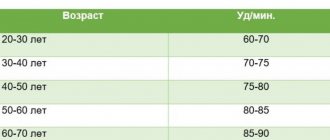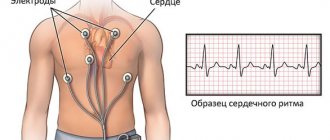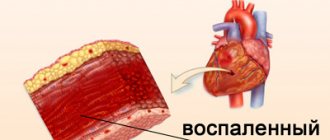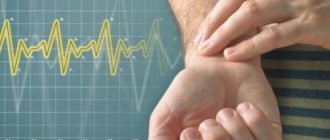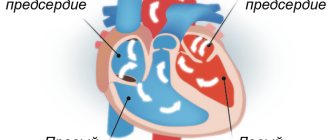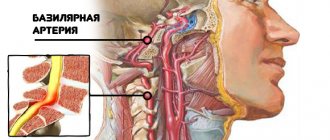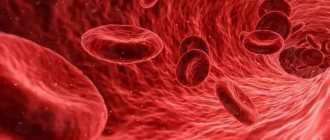It is believed that heart rate (HR) and pulse are the same concepts. But it is not so. Heart rate shows the contractions per minute of the lower parts of the heart, its ventricles, and the pulse rate is the number of dilations of the artery at the moment of blood ejection from the heart. As the blood passes through the vessels, it creates a bulge in the arteries, which can be determined by touch and, by placing two fingers on the wrist or neck, the number of beats per minute can be checked. Correspondence between heart rate and pulse rate can only be found in healthy people.
How many beats per minute should the heart beat normally?
A slow heart rate is a good sign. This indicates the ability of the heart to pump the required amount of blood in the minimum number of contractions. This also happens to a sleeping person, who consumes less nutrients and oxygen during sleep. With each passing year, the heart wears out, the muscles weaken, and the pulse increases. Usually its indicator corresponds to the person’s age. For example, upon reaching eighty years of age, a pulse corresponding to eighty beats per minute is considered normal.
Research into heart tonality using computer technology has enabled scientists to delve deeper into the secrets of the heart. It was found that the heartbeat of a healthy person is either accelerated or with some delay, while the heart rate of a patient with a pre-infarction condition is ideal. This discovery makes it possible to identify predisposition to cardiovascular diseases at earlier stages.
In infants, the pulse is twice as high as the pulse of an adult and is up to 140 beats per minute. But already during the first year of life, the pulse gradually decreases and by the age of six it is equal to one hundred beats per minute. By the age of 18-20 years, the pulse levels out and acquires its normal state - from 60 to 80 beats per minute.
Forecast by heart rate
“For a long time, the normal pulse rate was actually considered to be 60-80 beats per minute,” says cardiologist, professor, vice-rector for regional development and head of the Department of Hospital Therapy No. 1 of the Moscow State Medical and Dental University Yuri Vasyuk. “But recently large studies have been conducted in which hundreds of thousands of people were observed over several decades. As a result, it turned out that in healthy people the optimal heart rate is 55–60 beats/min. If the heart beats faster or slower, it increases the risk of a number of cardiovascular diseases.
Article on the topic
Dangerous cough. What atypical symptoms indicate a heart attack? A study of heart rate in diseases of the heart and blood vessels has shown that the higher it is, the higher the risk of heart attacks, strokes and other cardiovascular complications, including death from such diseases. Therefore, increased heart rate began to be officially considered an independent risk factor. Now a rapid heart rate is on a par with other risk factors for cardiovascular disease - smoking, high cholesterol, obesity, diabetes, high salt intake, etc.
As a result, scientists have revised the heart rate norms, and today it is believed that in patients with coronary heart disease, the pulse should be less than 70 beats/min, with arterial hypertension and chronic heart failure - less than 80 beats/min. If it is higher, the risk of complications and death increases significantly. Therefore, getting your heart rate below these values is one of the goals of treatment, as is reducing high blood pressure, cholesterol and other risk factors.
There is an explanation for these effects. The faster the pulse, the shorter the diastole - this is the time the heart muscle rests between heart contractions. It is in diastole that 90–95% of the blood flows to it. The lower the contraction frequency, the longer the diastole and the more oxygen the heart receives.
With arterial hypertension, the heart's need for oxygen increases, because it works with increased load, pushing blood into narrowed peripheral arteries. Because of this, hypertrophy of the heart muscle develops, and it requires even more oxygen and nutrients.
There is a hypothesis according to which any heart is programmed for a certain number of contractions. Accordingly, the lower the heart rate, the longer it can actively work. But it is confirmed only for heart rate in the range from 55 to 70–80 beats/min, and a decrease below 55 has the same unfavorable effect on the prognosis as an increase of more than 70–80 beats/min.”
Off the beat. How to restore heart rhythm Read more
Interesting facts about the influence of external conditions on heart rate
The Institute of Clinical Cardiology conducted experiments to study the causes of disruptions in the circulatory system. Laboratory rabbits were restricted in movement for 70 days. This led to atrophy of their muscle fibers (myofibrils), a decrease in the lumen of blood vessels, an increase in capillary walls and disruption of intercellular connections, which immediately affected the pulse rate. Watching a film with a sad plot by volunteers reduced the volume of current in the blood by 35%, and increased it by 22% when watching a comedy. Daily consumption of dark chocolate increases the efficiency of the human circulatory system by 14%.
The secret of a woman's heart
With the advent of fitness bracelets, which not only biohackers, but also almost everyone who even a little thinks about a healthy lifestyle can’t live without, the importance of heart rate has increased greatly. Many health parameters are tied to it, which are automatically determined by these smart devices. They can use the pulse to determine the level of physical activity that is optimal for weight loss and report this to the user. To calculate such important indicators as blood oxygen level, stress level, degree of physical fitness, and some others, pulse rate is needed. Finally, for heart patients there are gadgets that can send an SOS signal if the pulse becomes life-threatening.
All these smart devices also make it possible to conduct research that was previously impossible. For example, fitness bracelets, tracking the pulse over a long time, calculate such an indicator as the average heart rate at rest during the day (before them, the pulse could only be determined occasionally). This approach has already made several discoveries. This is evidenced by a huge study in the United States, in which 92.5 thousand Americans participated. It was recently published in the very influential scientific journal Public Library of Science (PLOS). The participants were observed for about a year, analyzing the information obtained using fitness bracelets.
Article on the topic
He got up and went. Lack of exercise is the cause of heart and joint diseases. Here are the main results. The average resting heart rate among Americans was 65.5 beats/min. But in general it fluctuated widely; there were people with an average heart rate of 40 beats/min and 109 beats. But 95% of men had a heart rate in the range from 50 to 80 beats/min, and 95% of women had a heart rate from 53 to 82. In all age groups, the average resting heart rate increased in people under 50 years old, and then decreased. But in women at any age, the heart beat a little faster. An interesting phenomenon was discovered among representatives of the fair sex who are of childbearing age: their pulse fluctuated more than that of men and other women. Researchers attribute this to different phases of the monthly cycle. They believe that with the help of a fitness bracelet it is possible to create an individual pulse graph showing which phase of the woman’s cycle she is in, and use this, for example, for contraception.
Here's another discovery: an unexplained increase in average resting heart rate preceded the onset of an acute infection or exacerbation of bronchial asthma. This can also be used in early diagnosis and prevention of such diseases.
According to the researchers, over time, average resting heart rate will be used as a unique source of individual physiological data. They are confident that each person has his own special graph of this indicator and, by analyzing it over a long period of time, it will soon be possible to obtain information not only about the patient’s cardiovascular system, but also about the condition of the lungs, detection of infectious diseases, reproductive health and many other things.
Heartbeat
The human pulse is a rhythmic oscillation of blood vessels that corresponds to the contractions of the heart. That is why the condition of the heart muscle is judged by their frequency. For example, the pulse can be used to characterize the strength and rhythm of the heartbeat and even the condition of the vessels through which blood flows. If the pulse loses its rhythm - it either becomes too fast, or slows down, or even begins to respond at irregular intervals - doctors begin to worry and check the patient for heart pathology, susceptibility to stress, or hormonal imbalances. Often, such failures can be a response to excessive coffee consumption.
Related article: My heart skipped a beat. When an arrhythmia becomes deadly Pulse indicators depend on many different criteria. For example, its frequency and even strength will be determined by a person’s age, exposure to environmental factors, and physical activity. The pulse also depends on the gender of a person: according to statistics, women knock more often than men. Children's heart rate will be significantly faster than adults'. This is especially true for babies.
As a rule, changes in the number and force of impacts are determined by various pathological processes. But there are a number of physiological reasons that can slightly reduce or speed up the heartbeat. So, for example, among them:
- Meals. After eating, a person’s heart rate often increases
- Inhalation height. Here the pulse also accelerates somewhat
- Changing body position, like physical activity, leads to an acceleration of the rhythm
- An increase in room temperature causes the heart to contract more often, because the blood thickens and more strength and energy is required to pump it
- Dream. Activity slows down during this time
In all these cases, if there is no pathological component, the pulse returns to normal quite quickly: 15 minutes is enough.
Minute blood volume
Blood IOC calculations
The minute volume of blood is the portion of blood that the ventricles eject into the vessels per unit time. In other words, it is the product of systolic or stroke volume and heart rate. IOC, like CO or SV, depends on age, gender, resting state or load:
- For newborns, normal IOC is within 340 ml;
- For children aged one year it is 1250 ml;
- At 7 years, the IOC is 1800 ml;
- In children aged 12 years, the IOC is 2370 ml;
- By the age of 16, the IOC indicators for girls are 3.8 l, for boys - 4.5 l;
- In adults, the normal IOC value is 4-6 liters.
With increasing load on the cardiovascular system, the IOC can increase to 30 liters per minute. In people involved in sports, IOC indicators can reach 40 liters per minute under conditions of physical activity.
Systolic volume
Normal values of systolic blood volume in children
The next main indicator of the functioning of the human heart is systolic or stroke volume of blood (SB, SV). It represents the volume (portion) of blood that the ventricles eject into the vessels during the systole phase. CO is an indicator that can vary depending on gender, age, and the functional state of the body. It is logical that during the physical period this figure increases, since working muscle mass must be supplied with additional blood volume.
Let's start with normal indicators of systolic blood volume in children:
- During the neonatal period, a stroke volume of 2.5 ml is considered normal;
- By the year this figure increases to 10.2 ml;
- At 7 years of age, a normal volume of CO is considered to be 28.0 ml;
- In children aged 12 years, the figure continues to increase and is 41.0 ml;
- From 13 to 16 years of age, blood volume is 59.0 ml.
Blood CO calculations
The normal values for stroke or systolic blood volume vary between children and adults. For men, this figure is 65-70 ml per systole, for women - 50-60 ml per systole. However, not all of the blood in the ventricles is released into the vessels. The resting systolic blood volume may be one-half or one-third of the total blood volume in the ventricle. This is necessary so that at the time of physical activity the ventricles have a reserve supply needed by the body.
Therefore, at the moment of physical or emotional overload, the human heart is capable of increasing the stroke volume by 2 times. Both the right and left ventricles should have approximately the same systolic volume. In other words, the portion of blood ejected by the ventricles must be the same. Blood CO can be calculated based on minute blood volume and heart rate (HRF). IOC divided by heart rate will be the systolic or stroke volume of blood.
Heart rate depending on age
Normal heart rate
- In the prenatal period, a normal heart rate is considered to be from 120-160 heart beats per minute.
- During the newborn period (up to one month, 29 days), the normal heart rate is considered to be from 110 to 170 heartbeats per minute.
- From one month to a year, heart rate indicators range from 102 to 162 contractions per minute.
- From one to two years, the heart rate level decreases to 154 beats at the upper limit and 94 beats at the lower limit.
- The next age period is from two to four years. The normal heart rate for a child at this age is 90 - 140 heartbeats per minute.
- At four to six years old, normal heart rate showed - from 86 to 26 heartbeats per minute.
- At six, seven and eight years old, 78-118 beats per minute is normal for a child.
- From 8 years to 10 years, the normal heart rate ranges from 68 to 108 beats per minute.
- At 10-12 years of age, the normal limit for children is between 60 and 100 beats per minute.
- At 12-16 years old, this indicator decreases to 55 beats per minute at the bottom and 95 beats per minute at the top.
- From 16 to 50 years, the boundaries of normal heart rate are within 60-80 beats per minute.
- From 50 to 60 years of age, normal heart rate is considered to be from 64 to 84 beats. per minute in an adult patient.
- From sixty to eighty years of age, normal heart rate is between 69 and 89 beats per minute.
Determination of heart rate on the carotid artery
Heart rate can be determined by palpation of the radial or carotid artery. Determination of the pulse on the radial artery in a healthy person corresponds to the heart rate. Palpation of the radial artery is performed by pressing the pads of the four fingers of the hand on the outer (lateral) surface of the hand. The thumb should be on the back of the hand. This method of determining the pulse should not cause difficulties.
If the radial artery lies deep or subcutaneous fat is pronounced, you can try to determine the pulse on the carotid artery. However, when determining the pulse in this way, you should be careful, since strong pressure can cause a decrease in blood pressure. The place for determining the pulse on the carotid artery is the lateral surface of the neck. It is necessary to turn your head as far as possible to the side. Due to this, an oblique contour of the neck muscle appears on the lateral surface of the neck.
By drawing a line from the upper edge of the thyroid cartilage (Adam's apple) to the anterior edge of this muscle horizontally, you can feel the pulsation of the carotid artery, after which you can determine the pulse. It is worth remembering that the pulse may not always coincide with the heart rate. This phenomenon is called pulse deficit. The volume of blood ejected by the ventricles does not reach the peripheral arteries. In such cases, the number of heart contractions exceeds the pulse rate in the peripheral arterial vessels. Pulse deficiency can be observed with atrial fibrillation and extrasystole.
